Vespula pennsylvanica / maculiforna / germanica / vulgaris / squamosa and Dolichovespula
The dog days of summer…fresh water melon, ice cream, picnics, barbecue, festivals…and yes, yellowjackets.
Yellowjackets are exceptionally troublesome wasps. They can become highly aggressive, especially when the available food is getting low later in the season when their colonies are getting larger.
While it can be annoying when wasps hover around soda cans at picnics and barbecues, these insects can be downright dangerous: they are responsible for most of the stinging deaths in the US.
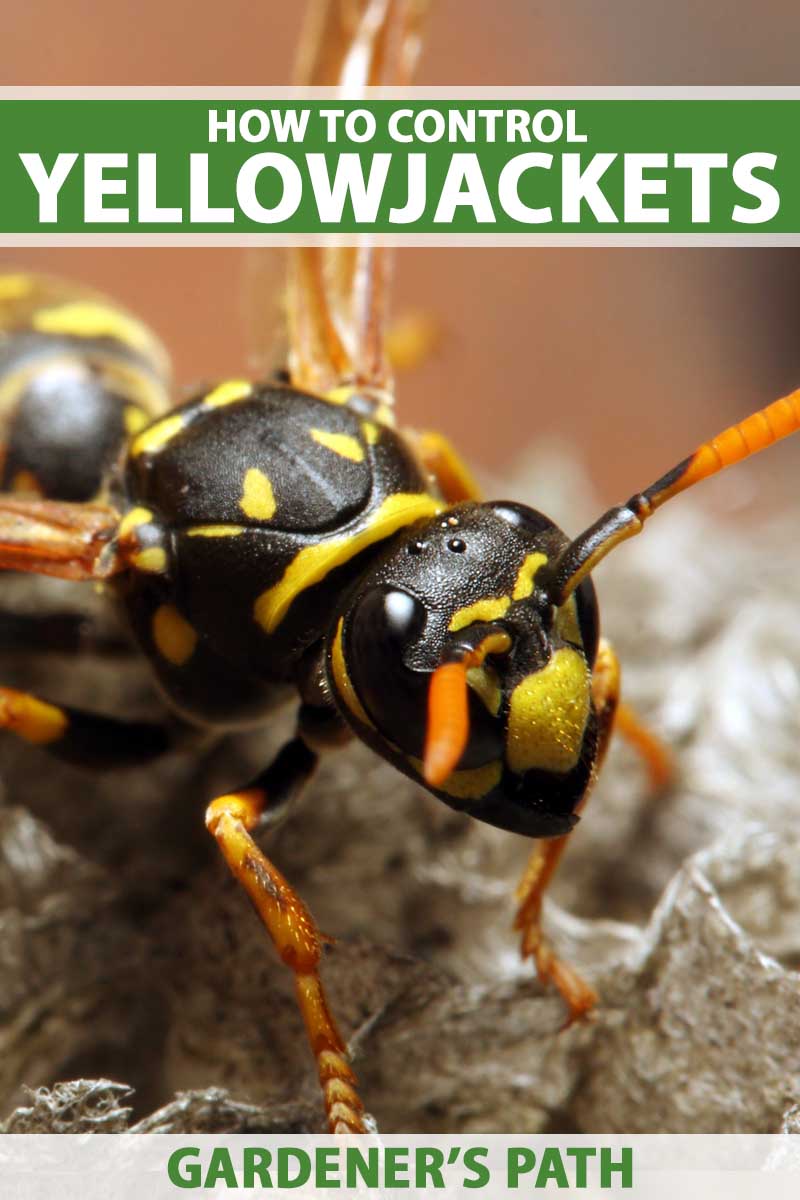
We link to vendors to help you find relevant products. If you buy from one of our links, we may earn a commission.
These wasps can keep stinging (unlike bees that die after one sting) plus large numbers of them can gang up on people.
Yellowjackets do have their uses – they prey on a large number of insects – including many that are damaging to agriculture.
However, their tendency to bite and sting generally makes them unwelcome residents of a yard or, perish the thought, a house!
In this article, we will discuss the different species and approaches you can take to minimize the harm they could cause you.
What You Will Learn
Types of Yellowjackets
There are two genera of yellowjackets – Vespula and Dolichovespula – both in the family Vespidae, a huge family that primarily includes social wasps that live in colonies.
And within those genera, there are multiple species, some of the most common (to North America and Europe) being:
The western yellowjacket, Vespula pennsylvanica, is the most common type in the western US. It nests in the ground, and is sometimes referred to as the “meat bee.”
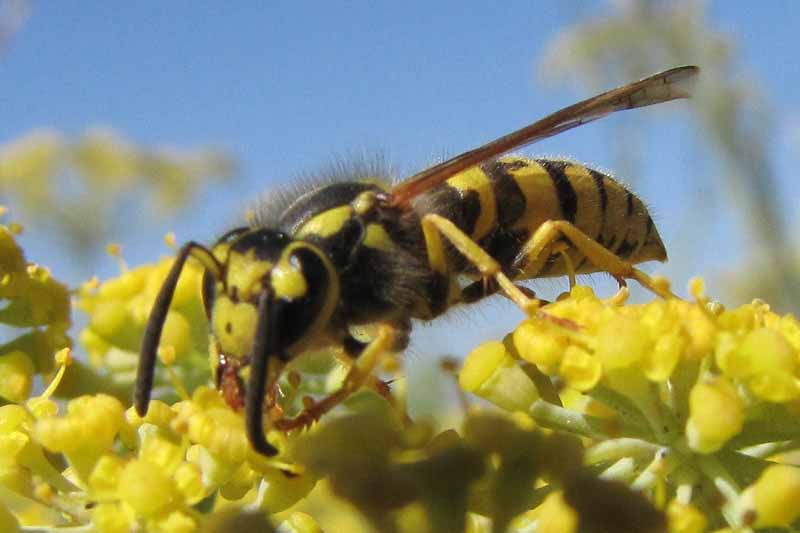
The eastern yellowjacket, Vespula maculiforna, is its counterpart on the East Coast of North America and can have nests underground or in cavities such as hollows in trees.
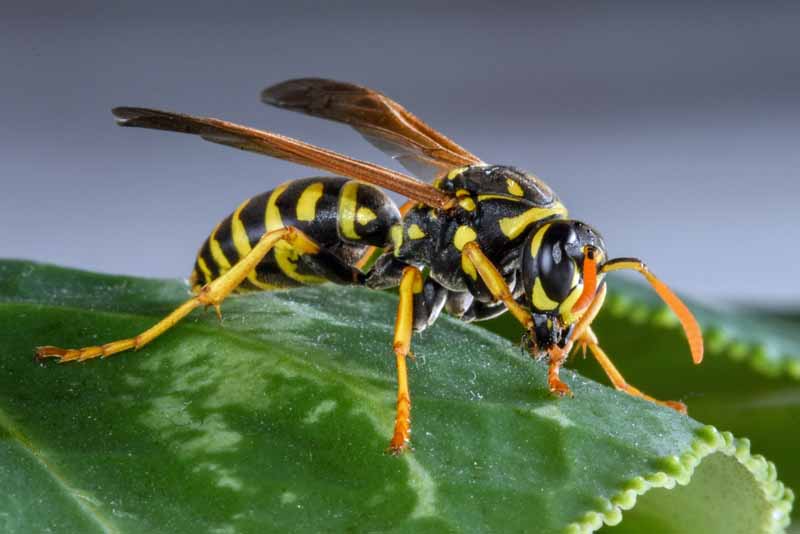
The German yellowjacket, Vespula germanica, is more of an urban wasp and frequently nests in houses! It only appeared in the US in 1975, but it has overtaken the eastern species as the dominant type in many parts of the country.

In contrast, Vespula vulgaris, or the common wasp, nests in rotten tree stumps at higher elevations.
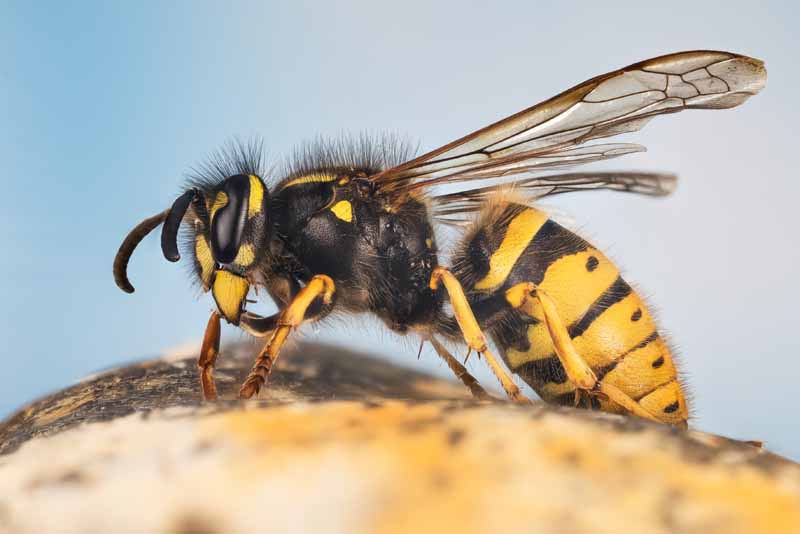
Species of Dolichovespula nest in trees.

In the southeastern part of the US, the colony sizes of the ground nesting southern yellowjacket (Vespula squamosa) can reach as many as 100,000 adult wasps due to their ability to persist through the winter.
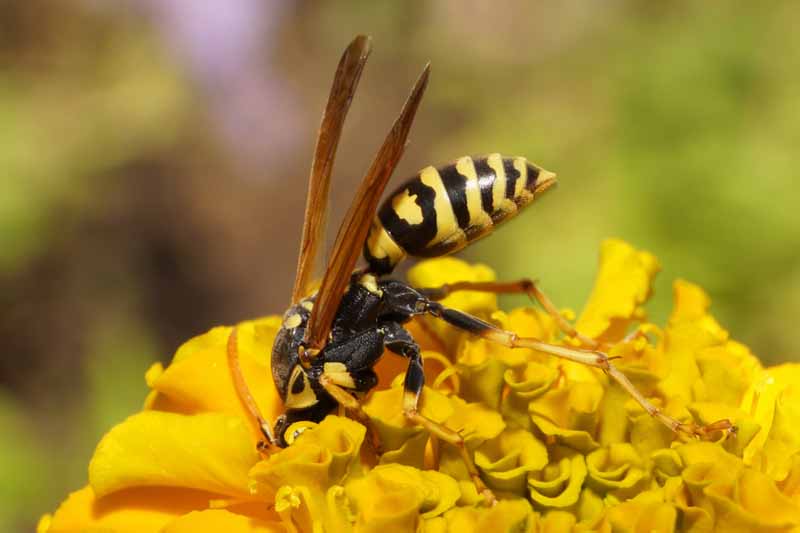
Identification, Life Cycle, and Biology
All of the yellowjackets share common characteristics that distinguish them from bees.
They are medium sized and black with yellow stripes, with the exception of D. maculate. Due to its atypical black and white coloration, D. maculate is actually known as the bald-faced hornet.
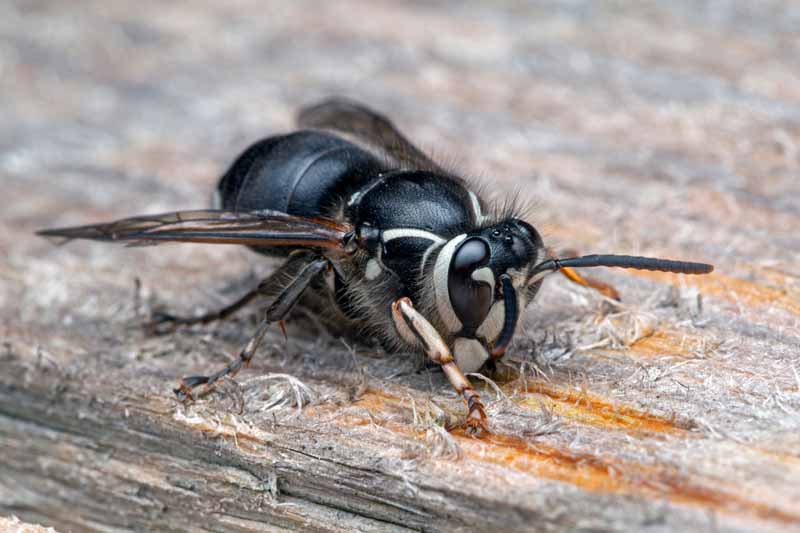
A critical difference is that all of these wasps have very tiny waists, where bees do not. They are also not hairy, and they don’t have flattened hind legs to carry pollen like bees do.
Typically, the workers are about half an inch long, while the queens are about three-quarters of an inch long.
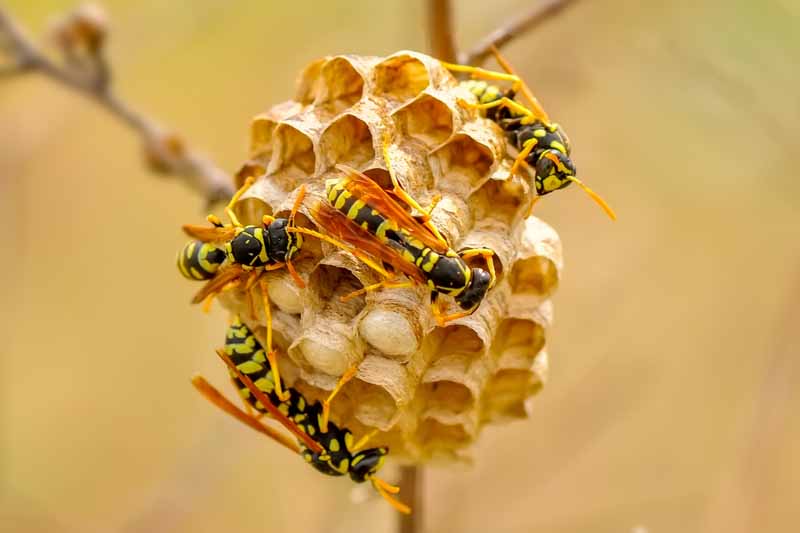
The queens have compounds that act as a kind of antifreeze in their blood, which enables them to survive the cold temperatures that kill the rest of the colony.
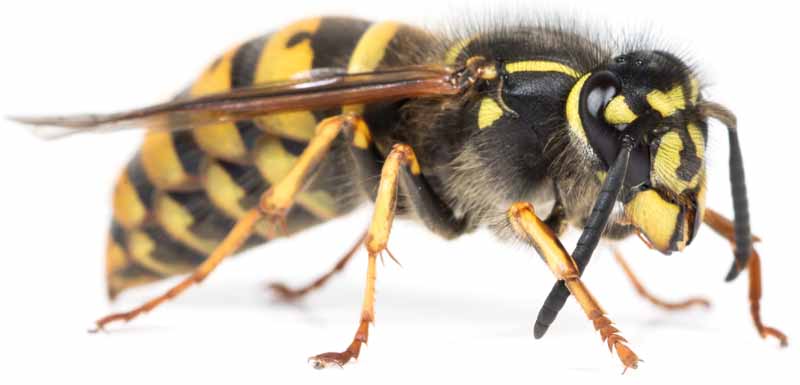
The queen emerges from hibernation in late winter to start a new colony. She creates a nest by chewing wood fiber into a pulp that is similar to paper.
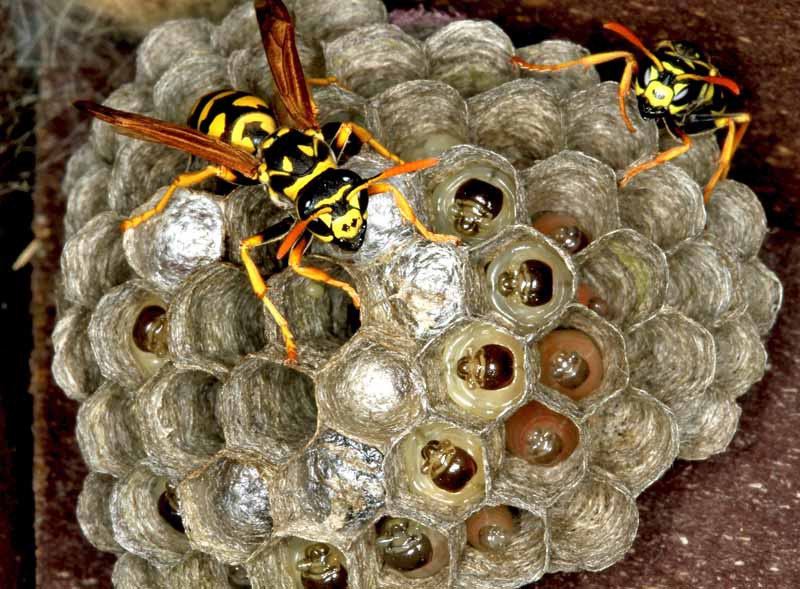
The queen then lays a relatively small number of eggs that become larvae after they hatch. These larvae are the first batch of workers.
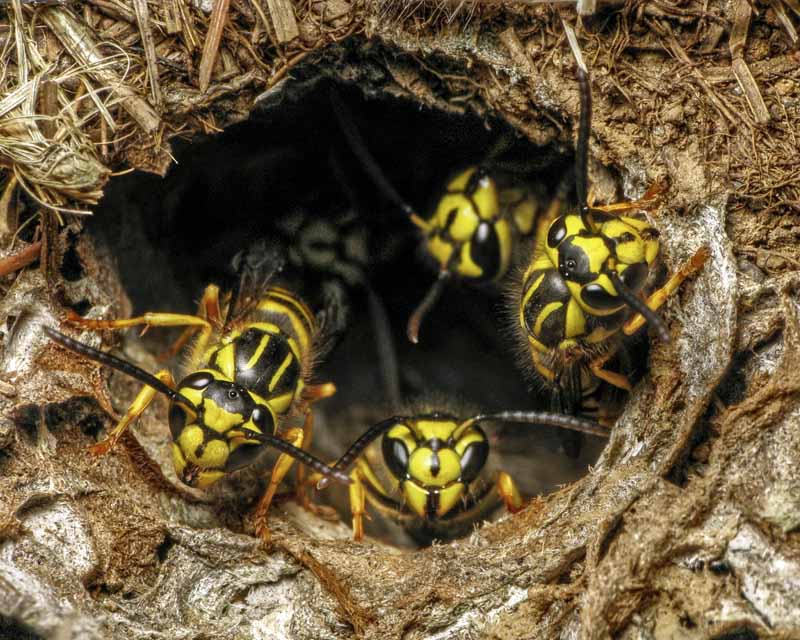
These workers perform all of the functions for the nest except for laying eggs.
Colony Behavior Varies Throughout the Summer
The colonies grow rapidly between spring and midsummer.
The larvae need a lot of protein, and the workers typically forage for other insects.
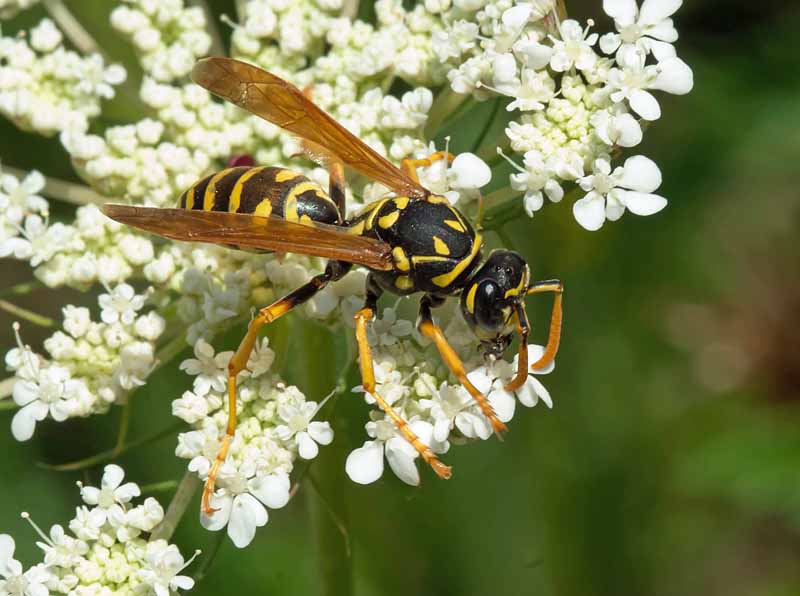
However, by the end of the summer, the colonies need a lot of sugar.

While some types of yellowjackets only collect live prey, others – especially certain Vespula species, including the eastern yellowjacket and V. flavopilosa and V. vulgaris – are often scavengers.
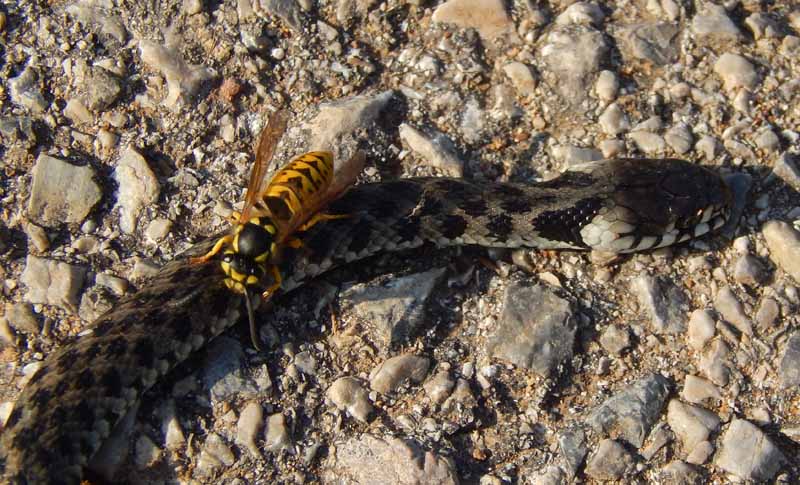
These scavengers are frequently the species that are pests at picnics and other outdoor activities that have food or soda cans present.
Late summer is also the time of year that the hive produces new queens and males.
The old queen dies, but the newly fertilized one will overwinter in a sheltered site such as under bark.
Typically, there is only one colony. However, the colonies can overwinter and become quite large in areas where it is warm.
This was the case in Alabama in 2006 and happened again in 2019.
Agricultural Uses of Yellowjackets
Believe it or not, there is something good about these widely hated wasps.
Colonies eat tremendous amounts of insects during the initial part of their life cycle. For example, they are predators of agricultural pests such as armyworms and corn earworms.
However, these wasps can do extensive damage to fruit.

This can result in major losses in commercial orchards, but these wasps will also attack the fruit growing in home gardens. Tomatoes, pears, apples, stone fruits, and grapes are popular targets for these pesky insects.
Injuries from the Stings
While all types sting when provoked, the German variety is exceptionally aggressive and will pursue anything or anyone disturbing their nests.
While one person might find a sting to be merely a painful annoyance, others are sensitive to the venom and can become ill.
More frequent stings may result in greater sensitivity to the venom.
Be very careful about drinking from a soda can that could have a yellowjacket inside because stings inside the mouth can be life threatening.
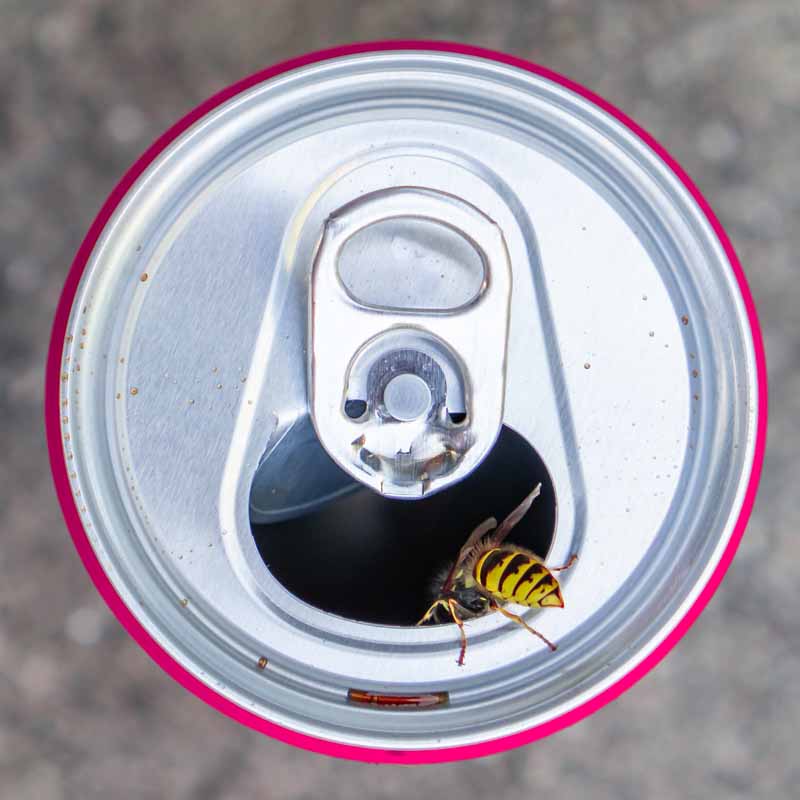
The tendency of these wasps to sting in large numbers can make these stings a very serious matter.
As mentioned, most of the deaths from stings in the US are due to yellowjackets, and most fatalities occur within an hour of being stung.
A large number of stings can introduce a lot of foreign protein into a person’s body and also cause tissue damage because of destructive enzymes contained in the venom.
If you have a strong allergic reaction after being stung, you should seek medical help immediately. Symptoms include hives, extensive swelling, dizziness, wheezing, or difficulty swallowing.
How to Minimize the Numbers of Yellowjackets in Your Yard
Some people are avid about destroying the nest during the wasps’ active season.
Dousing them with gasoline or a hose is not a good idea and is a way to get stung multiple times.
Avoidance is Your Best Bet
Now that you are aware of how serious their stings can be, hopefully you want to minimize your exposure to these insects.
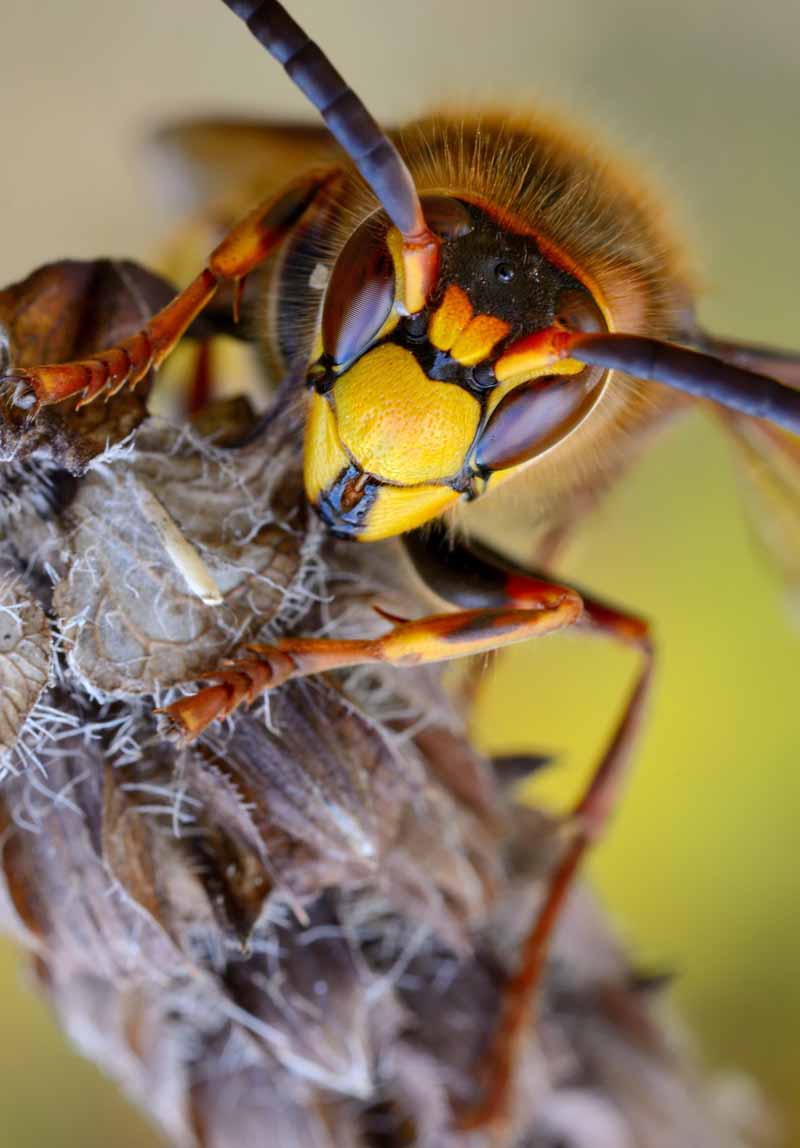
You should be wary of small patches of ground with no vegetation, as these areas can harbor underground nests.
However, when foraging, yellowjackets are away from their nests, and they are much less aggressive and usually won’t sting unless you provoke them.
Stay calm and collected and do not swat at the insect.
Lure Traps
While spraying the nests can range from intimidating to downright dangerous, there are some types of traps you can set up to catch these wasps and put them out of commission.
This approach should be restricted to yellowjackets and not used with other kinds of wasps.
Lure traps are the easiest types to use and can be purchased at many retail stores or online.

RESCUE Non-Toxic Reusable Trap for Yellowjackets via Amazon
These kinds of traps will reduce the number of foraging insects but won’t control large numbers of yellowjackets.
The most common type of lure is heptyl butyrate, but this chemical primarily attracts the western yellowjacket and not the other species.
You can add other lures to the trap to help it attract other varieties.
For example, adding meat like chicken will help the trap attract the German yellowjacket and V. vulgaris. You should frequently replace the meat, since these insects don’t like rotting meat.
You can use fruit juice or jelly to attract those species that desire sweet nectar rather than protein.
Also, check the lures periodically to make sure they are still working and follow the manufacturer’s recommendations about replacing them.
If you are using a lure trap in your backyard, put it along the edge of the property and as far away as you can from areas like your patio!
They will typically travel up to a quarter of a mile for food.
Water Traps
You can make this kind of trap yourself using a five-gallon bucket, protein bait – such as ham, fish, turkey, or liver – and a piece of string.
You should fill the bucket with soapy water, and use a piece of string to hang the protein bait a couple of inches above the water. Be sure and put a wide-mesh screen over it, so the insects can get in, but animals won’t abscond with the meat.
After the insects remove the protein, they fly down into the soapy water and drown.
This type of trap will catch some foragers, although not huge amounts of them.
However, it can be very useful for catching the queen in the late winter or early spring.
Sanitation
This low-tech technique can go a long way toward reducing the threat of marauding wasps and hornets of all sorts.
Keep your food outside covered until you need it. Clean up spills promptly. Put tight-fitting, self-closing lids on your trashcans.
Put a plastic liner in your can and empty and clean it often.
Repellants
While mosquito repellant won’t do you any good, you can make your own yellowjacket repellant out of water and ammonia.
Add about six ounces of ammonia to a gallon of water. Then sponge it onto eating areas and treat the trash cans with it as well.
This solution will help mask the odors of the food and should result in lower populations of these unwelcome visitors.
Destruction of the Nests
You can find instructions on how to destroy nests throughout the internet. However, this can be a dangerous practice, and is best left to professionals.
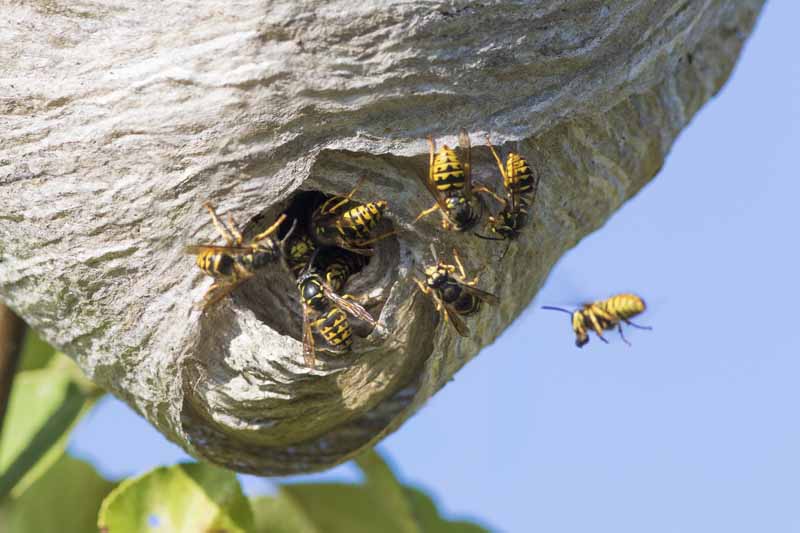
While there are strong aerosol products that you can use, and even ones that claim to freeze the wasps, these pests may still try to attack you.
Even if you wait and come back the next day, you may be faced with “partially intoxicated, agitated wasps” some distance from the nest.
If you do go this route, wear heavy protective clothing like those of beekeepers, including gloves and a veil over your face.
Be Careful with Your Flashlight
Experts recommend treating the nest at night when the wasps are less easily provoked.
Be careful not to shine your flashlight into the nest, so you won’t provoke the wasps.
You can protect yourself by putting red cellophane or acetate over the lens. That type of light doesn’t agitate the yellowjackets as much.
And consider putting your flashlight on the ground.
Insecticidal Dust
You can buy wasp and hornet aerosol sprays, but some people find that an insecticidal dust works especially well.
If you don’t have a duster, you can fill an empty detergent bottle half full and use that. Put a few pebbles at the bottom to prevent the dust from caking.
The formulations endiocarb (Ficam®), or pyrethrins and silica gel (Drione®) have been found to be effective.
If there is more than one opening, you should seal the other ones before you start your assault.
And then seal the opening once you have applied the insecticide!
Outsource to Professionals
These stinging insects are notoriously defensive when protecting their nest.
This might be a prudent time to hire a pest professional to have them do the job for you.
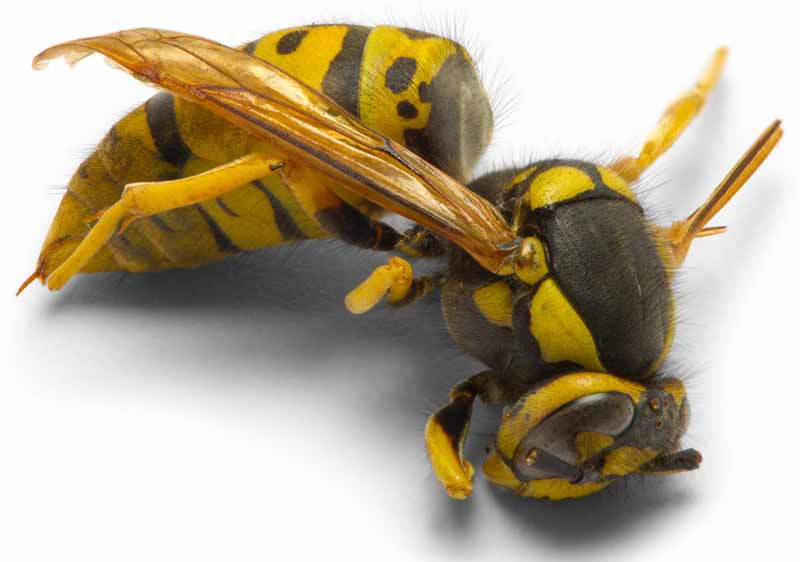
In some parts of California, personnel from your local mosquito and vector control district can take care of the nests for you.
And if you encounter one of those super nests that can contain 15,000 or more wasps, you will absolutely want to seek help from professional pest control experts.
Kill the Queen Before She Creates More Workers
Just like chess, you want to capture the queen. Only this is no game, and you want to kill her!
The best time to do this is when she emerges in the spring to find a new place to nest.
Once she starts laying eggs, it will take a month for them to hatch, so you have ample time to strike.
Potential nest sites include:
- Rodent burrows that are uninhabited
- Dense shrubs
- Clustered tree branches
- Garages
- Sheds
- Houses:
- Attics
- Behind wall siding
- Under eaves or porches
- In hollow floors and walls
You should take a three-step approach to identify the site of the new nest:
- Try to identify nest sites and queens in their nest-hunting flights by regularly scouting your property
- Take preventative measures. Fill rodent burrows will soil. Screen in places like openings into your house, garage, or shed.
- If you find a nest, kill the queen with a fly swatter! And then dispose of the nest. You must proceed in that order, or the queen will attack you while she tries to protect her nest. (If you are too afraid to do this, set a trap for her.)
Yellowjackets Can be Too Much of a Good Thing
At least in the beginning of the season, these omnivorous insects help farmers by eating large quantities of agricultural pests.
However, their tendency to sting repeatedly in large numbers makes them very unwelcome guests in most home gardens and backyards.
You can use lures in your yard to trap some of the foraging insects.
Spraying nests can be fraught with danger but tracking down the queen in the spring before she has created a new colony is the perfect time to eliminate her and the potential colony.
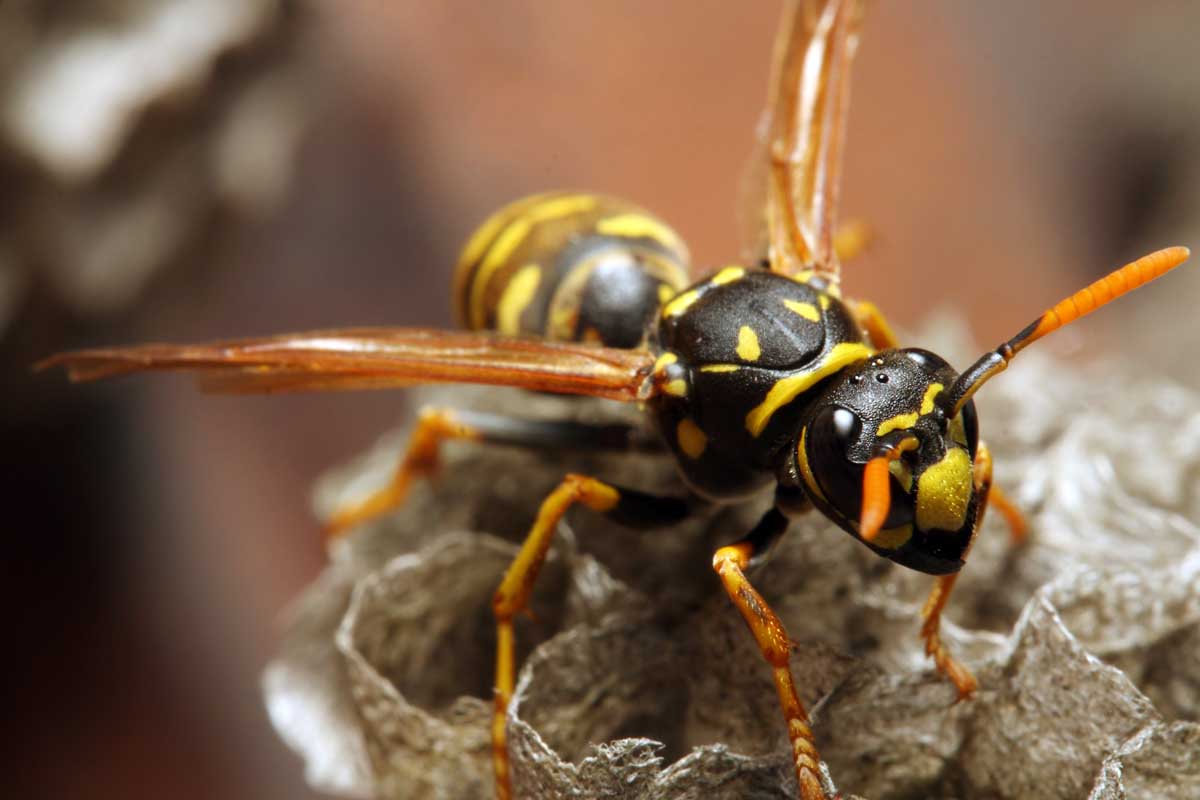
The rise of super nests, such as those appearing in Alabama at the time of this writing, are alarming harbingers of what can happen as the climate warms.
Seek professional pest control help if you encounter one of these monstrosities.
Let us know if you had a memorable experience with yellowjackets in the comments section below.
And if you found value in this guide, be sure to check out some of our other pest guides next:
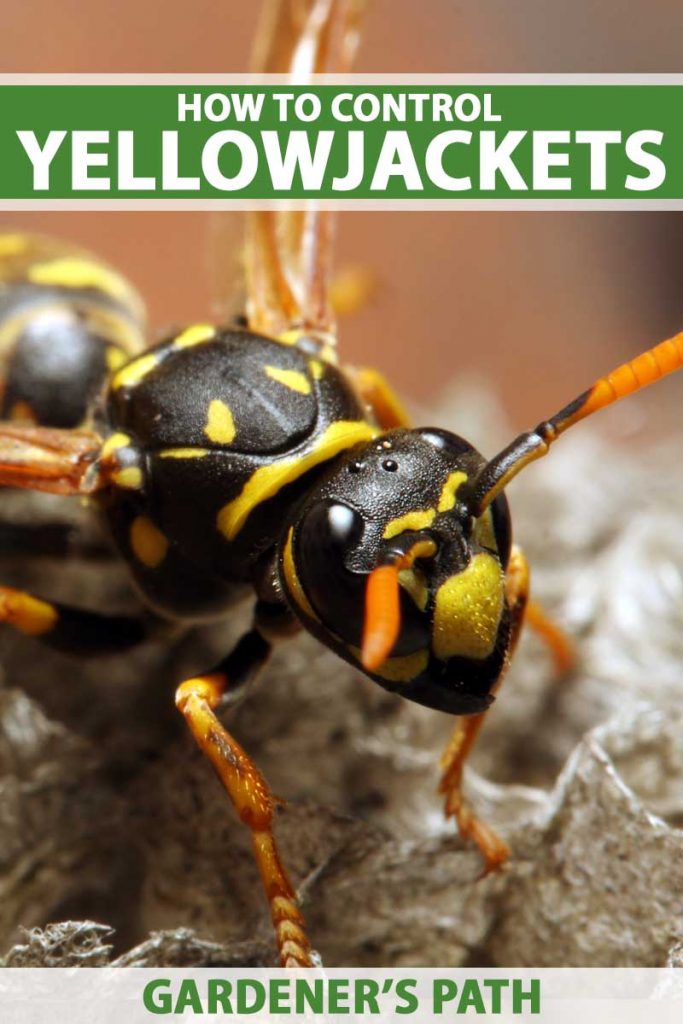
Very useful information I did not know. I know injuring one yellow jacket, they call for help. Nasty boys.
Hi Fred,
Thank you so much for taking the time to comment! We really appreciate it.
They do indeed get nasty and cause the greatest number of fatalities of any stinging insect in the US.
They are not nasty. If you call for help, is anyone that helps an injured person nasty? They eat garden pests. On the whole they’re beneficial.
You are equating an injured wasp to a person?! You get yourself stung and it will be nasty! Yes, they can be beneficial in the garden but I have no qualms eliminating them in my space.
Great article! This year, I had 2 run-ins. First time, I got stung in my driveway, just walking. No big deal. I thought it was just a wrong place at the wrong time. 2nd time, I got stung 3x’s. I disturbed their nest, they attacked my dogs and me! Luckily, I knew they chase you. I ran into the garage, closed the door and we swatted until they were goners. Very upsetting! Looking around, we found 2 nests. Working on destroying them now. Internet said vinegar is good. We’re having success so far. I’m amazed that there’s more than 1… Read more »
Hi Susan,
We’re so glad you liked the article!
I’m so sorry to hear that you were swarmed! That sounded pretty traumatic.
I’m glad to hear that the vinegar is working, and I hope that it will take care of the problem.
Great information. I started to see one or two inside my house by the kitchen window and I’m able to kill them when I see them. I eventually located a crevice in my foundation outside where 5-6 are flying in and out. I sprayed with a Yellowjacket killer but didn’t seem to help. I read that they die in the winter. Will the queen stay in the nest over winter? I wanted to plug up the hole with foam insulation but now I’m afraid they might start using the “inside” exit (where ever that is) and start swarming in the… Read more »
Hi Jim,
We’re so glad you liked the article!
Your situation sounds dreadful and stressful.
The queens do hibernate over the winter, although there is no guarantee that she will nest in the same location.
I’m not sure, but I wonder if they would chew through the foam if you use that type of insulation.
Unfortunately, I’m really not sure what to advise. Have you considered bringing in a professional exterminator? He or she might be able to help you.
Please let us know when you find a solution!
I have seen yellow jackets all of my life.. but the three I have seen inside my home are larger than any I have ever seen. We had a freak cool snap in Alabama the first of may and this was when I saw the first one.. it was under a lamp shade that was on.. I saw the shadow.. managed to kill it and two nights later, there was another.. I couldnt believe what these things looked like.. so a couple of weeks pass and it is warm Alabama weather and there is one on the shower curtain rod… Read more »
Oh dear, it’s never fun when you find yellowjackets in the house. This looks like an Eastern yellowjacket (Vespula maculifrons). They usually build nests underground or in dense shrubs, but they can also build inside the walls of your house, which is what it sounds like might be happening here. If that’s the case, it’s probably best to call a pro that can identify the nest and help you eliminate it.
Karen this happened in my house 2 years ago as well. They were small, maybe the babies, but I had 8-10 coming in the bathroom through poorly installed window frame/trim per day, for two weeks. We only have one bathroom, as well! I had to seal around the window trim and eliminate any shafts of light they might have been seeing inside the house. I know that feeling of always on edge. I haven’t seen any more indoors since I sealed the window trim.
Thank you! This was the most informative, helpful article I have read about yellow jackets. They have been a nuisance at my drive thru coffee shop for years. I have not been stung yet, as they just seem to be foraging and are attracted to the syrups garbage container outside. Most customers are fearful, and some have good reason because of allergies. It’s time to stop with the wasp drama we contend with every summer. Thanks, wish me luck!
I hope you get it sorted out Christine!
Hello. I agree with Christine — and hope for the best!!! Another solution — I use it regularly — is to spray the […] with soapy water. Put some six fluid ounces of water in a used spray bottle with a nozzle that can send out a wide spray or a narrow one (mine is a used Lysol bottle), and add some 10-15 drops of liquid soap (I use dish soap). I first hit the wasp with a steady spray for some five seconds and follow it as it flies away from the nest (a wide spray will do at… Read more »
We’ve had a nest underneath our front door threshold for a couple months. Can’t even use our front door! I was stung after one got inside the house. Hurt for a solid WEEK! Mean boogers!!!!! My husband tried blasting them out with an air hose, sprayed wasp spray, but we have no idea how far back into the foundation/under the threshold they are. Last night, they stung our dog multiple times. NOW they REALLY gotta go! We may have to call in professionals. Any suggestions? Thanks!
I guess I have been lucky – I thought they were some sort of bee and every morning on my deck they are busy taking wood and flying off. They didn’t seem to be aggressive. They land on me and then fly off. They landed on my dog and then fly off. One was on my shoulder and I didn’t know and went into the house – then I didn’t know and pushed it off and it landed on my table. So I picked it up with paper towel and set it free in the yard. I caught two in… Read more »
Hello Eleen. It’s possible you’re meeting the worker yellow jackets, or that you’ve come across them earlier in the season when there aren’t as many and they’re not as aggressively pursuing food as they must later. But it’s always best to give them their space, even though they sure are beautiful up close.
I recently saw some very fuzzy wasps in my school soccer field during lunch break, and to my surprise they were really fuzzy! (Abdomen excluded) I was used to seeing some of the smooth wasps out and I was curious as to why they were fuzzy now instead of smooth. I almost mistook it for one of those imitation bees that can’t actually sting, and then it went after my friend’s applesauce. It hovered around us and landed on several things, but it didn’t look like its stinger was ready, and was just after applesauce. It was strange, because several… Read more »
These are beneficial insects.
Hello Casey Donohue. I hope it came across in this article that yellow jackets do have benefits, especially when they consume insect pests that plague vegetable gardens.
But we can all agree that they can also be dangerous, particularly when they sting someone who’s extra-vulnerable to their venom, or sting repeatedly or in a person’s mouth.
We do advocate “avoidance” as the first line of defense and ask gardeners and homeowners only to escalate to stronger measures if they can’t seem to avoid the yellow jackets..
Thanks for reading and giving your input.
Rattlesnakes are also beneficial but out in the woods, not in or near my house. One of the “beneficial” little creatures landed my wife in the ER, taken there by ambulance. Nope! I kill these beneficial creatures whenever I see one of them.
Last August an animal destroyed a yellow jacket nest in a box on our deck stung my husband while he was taking out the garbage and later that night caused me to fall fully tear my ACL 4 hours later when we got home from the ER at 1am they were still agressive and swarming hubby had to use wasp killer spray foe me to hobble into the house. Our area has an infestation of them. Everyone in our area has issues with them
Alana, that’s unfortunate, indeed. You and others in your area have our sympathy.